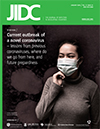Clinical comparison of two human papillomavirus detection assays: GenoFlow and reverse line blot
DOI:
https://doi.org/10.3855/jidc.11769Keywords:
Detection and Genotyping, HPV-DNA, Sexual Transmitted Infections, Women’s HealthAbstract
Introduction: Human papillomavirus (HPV) infection is typically critical in the oncogenesis of cervical cancer. However, available HPV detection kits differ in their ability and sensitivity to detect various types of HPV, and this variability has led to inconsistencies in the reporting of the geographic prevalence of HPV types, especially in developing countries. Here, we compared results of the recently developed GenoFlow HPV array test, which detects 33 HPV genotypes, to those of the well-established reverse line blot (RLB) assay, which detects 23 HPV types.
Methodology: In total, 608 cervical specimens with cytology results ranging from normal to cancer were collected using an endocervical brush from women attending outpatient clinics in Riyadh, Saudi Arabia.
Results: Sixty-nine specimens (11%) were positive for HPV. HPV genotype detection using the GenoFlow test had a sensitivity of 62% and a specificity of 100%. Overall agreement between the two HPV genotyping methods was 97%, with a concordance rate of 95%. Among the GenoFlow test results, 2% indicated additional HPV types that were not detected in the RLB assay, whereas the GenoFlow test missed 0.3% of the HPV types that were detected by the RLB; however, both tests were in agreement in detecting all major HPV types.
Conclusion: The GenoFlow test was reliable, with results comparable to the RLB test. However, because the GenoFlow test is less labor-intensive and takes less total time (3 hours), it is a promising, affordable alternative to the RLB for HPV diagnosis and screening programs.
Downloads
Published
How to Cite
Issue
Section
License
Authors who publish with this journal agree to the following terms:
- Authors retain copyright and grant the journal right of first publication with the work simultaneously licensed under a Creative Commons Attribution License that allows others to share the work with an acknowledgement of the work's authorship and initial publication in this journal.
- Authors are able to enter into separate, additional contractual arrangements for the non-exclusive distribution of the journal's published version of the work (e.g., post it to an institutional repository or publish it in a book), with an acknowledgement of its initial publication in this journal.
- Authors are permitted and encouraged to post their work online (e.g., in institutional repositories or on their website) prior to and during the submission process, as it can lead to productive exchanges, as well as earlier and greater citation of published work (See The Effect of Open Access).








